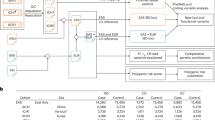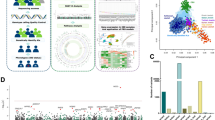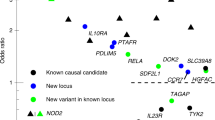Abstract
Genome-wide association studies and candidate gene studies in ulcerative colitis have identified 18 susceptibility loci. We conducted a meta-analysis of six ulcerative colitis genome-wide association study datasets, comprising 6,687 cases and 19,718 controls, and followed up the top association signals in 9,628 cases and 12,917 controls. We identified 29 additional risk loci (P < 5 × 10−8), increasing the number of ulcerative colitis–associated loci to 47. After annotating associated regions using GRAIL, expression quantitative trait loci data and correlations with non-synonymous SNPs, we identified many candidate genes that provide potentially important insights into disease pathogenesis, including IL1R2, IL8RA-IL8RB, IL7R, IL12B, DAP, PRDM1, JAK2, IRF5, GNA12 and LSP1. The total number of confirmed inflammatory bowel disease risk loci is now 99, including a minimum of 28 shared association signals between Crohn's disease and ulcerative colitis.
This is a preview of subscription content, access via your institution
Access options
Subscribe to this journal
Receive 12 print issues and online access
$209.00 per year
only $17.42 per issue
Buy this article
- Purchase on Springer Link
- Instant access to full article PDF
Prices may be subject to local taxes which are calculated during checkout
Similar content being viewed by others
Change history
11 August 2011
In the version of this article initially published, an affiliation was missing for two authors, Maria Gazouli and Nicholas P. Anagnou. They are also affiliated with the Foundation for Biomedical Research of the Academy of Athens in Athens, Greece. The error has been corrected in the HTML and PDF versions of the article.
References
Xavier, R.J. & Podolsky, D.K. Unravelling the pathogenesis of inflammatory bowel disease. Nature 448, 427–434 (2007).
UK IBD Genetics Consortium. et al. Genome-wide association study of ulcerative colitis identifies three new susceptibility loci, including the HNF4A region. Nat. Genet. 41, 1330–1334 (2009).
Festen, E.A. et al. Genetic variants in the region harbouring IL2/IL21 associated with ulcerative colitis. Gut 58, 799–804 (2009).
Franke, A. et al. Genome-wide association study for ulcerative colitis identifies risk loci at 7q22 and 22q13 (IL17REL). Nat. Genet. 42, 292–294 (2010).
McGovern, D.P. et al. Genome-wide association identifies multiple ulcerative colitis susceptibility loci. Nat. Genet. 42, 332–337 (2010).
Franke, A. et al. Replication of signals from recent studies of Crohn's disease identifies previously unknown disease loci for ulcerative colitis. Nat. Genet. 40, 713–715 (2008).
Dideberg, V. et al. An insertion-deletion polymorphism in the interferon regulatory factor 5 (IRF5) gene confers risk of inflammatory bowel diseases. Hum. Mol. Genet. 16, 3008–3016 (2007).
Asano, K. et al. A genome-wide association study identifies three new susceptibility loci for ulcerative colitis in the Japanese population. Nat. Genet. 41, 1325–1329 (2009).
Zhernakova, A. et al. Genetic analysis of innate immunity in Crohn's disease and ulcerative colitis identifies two susceptibility loci harboring CARD9 and IL18RAP. Am. J. Hum. Genet. 82, 1202–1210 (2008).
Kugathasan, S. et al. Loci on 20q13 and 21q22 are associated with pediatric-onset inflammatory bowel disease. Nat. Genet. 40, 1211–1215 (2008).
Dubois, P.C. et al. Multiple common variants for celiac disease influencing immune gene expression. Nat. Genet. 42, 295–302 (2010).
Kuester, D. et al. Aberrant methylation of DAPK in long-standing ulcerative colitis and ulcerative colitis-associated carcinoma. Pathol. Res. Pract. 206, 616–624 (2010).
Koren, I., Reem, E. & Kimchi, A. DAP1, a novel substrate of mTOR, negatively regulates autophagy. Curr. Biol. 20, 1093–1098 (2010).
Franke, A. et al. Genome-wide meta-analysis increases to 71 the number of confirmed Crohn's disease susceptibility loci. Nat. Genet. 42, 1118–1125 (2010).
Turner, C.A. Jr., Mack, D.H. & Davis, M.M. Blimp-1, a novel zinc finger-containing protein that can drive the maturation of B lymphocytes into immunoglobulin-secreting cells. Cell 77, 297–306 (1994).
Martins, G.A., Cimmino, L., Liao, J., Magnusdottir, E. & Calame, K. Blimp-1 directly represses Il2 and the Il2 activator Fos, attenuating T cell proliferation and survival. J. Exp. Med. 205, 1959–1965 (2008).
Kallies, A., Xin, A., Belz, G.T. & Nutt, S.L. Blimp-1 transcription factor is required for the differentiation of effector CD8(+) T cells and memory responses. Immunity 31, 283–295 (2009).
Grenningloh, R., Kang, B.Y. & Ho, I.C. Ets-1, a functional cofactor of T-bet, is essential for Th1 inflammatory responses. J. Exp. Med. 201, 615–626 (2005).
Moisan, J., Grenningloh, R., Bettelli, E., Oukka, M. & Ho, I.C. Ets-1 is a negative regulator of Th17 differentiation. J. Exp. Med. 204, 2825–2835 (2007).
Sabath, E. et al. Galpha12 regulates protein interactions within the MDCK cell tight junction and inhibits tight-junction assembly. J. Cell Sci. 121, 814–824 (2008).
Bettelli, E., Korn, T., Oukka, M. & Kuchroo, V.K. Induction and effector functions of T(H)17 cells. Nature 453, 1051–1057 (2008).
Steinberg, M.W. et al. A crucial role for HVEM and BTLA in preventing intestinal inflammation. J. Exp. Med. 205, 1463–1476 (2008).
Maerten, P. et al. Involvement of 4–1BB (CD137)-4–1BBligand interaction in the modulation of CD4 T cell-mediated inflammatory colitis. Clin. Exp. Immunol. 143, 228–236 (2006).
Mahida, Y.R., Wu, K. & Jewell, D.P. Enhanced production of interleukin 1-beta by mononuclear cells isolated from mucosa with active ulcerative colitis of Crohn's disease. Gut 30, 835–838 (1989).
Williams, E.J. et al. Distribution of the interleukin-8 receptors, CXCR1 and CXCR2, in inflamed gut tissue. J. Pathol. 192, 533–539 (2000).
Noble, C.L. et al. Regional variation in gene expression in the healthy colon is dysregulated in ulcerative colitis. Gut 57, 1398–1405 (2008).
Schluns, K.S., Kieper, W.C., Jameson, S.C. & Lefrancois, L. Interleukin-7 mediates the homeostasis of naive and memory CD8 T cells in vivo. Nat. Immunol. 1, 426–432 (2000).
Yamazaki, M. et al. Mucosal T cells expressing high levels of IL-7 receptor are potential targets for treatment of chronic colitis. J. Immunol. 171, 1556–1563 (2003).
Gregory, S.G. et al. Interleukin 7 receptor alpha chain (IL7R) shows allelic and functional association with multiple sclerosis. Nat. Genet. 39, 1083–1091 (2007).
Fumagalli, M. et al. Parasites represent a major selective force for interleukin genes and shape the genetic predisposition to autoimmune conditions. J. Exp. Med. 206, 1395–1408 (2009).
Pandey, A.K. et al. NOD2, RIP2 and IRF5 play a critical role in the type I interferon response to Mycobacterium tuberculosis. PLoS Pathog. 5, e1000500 (2009).
Liu, L. et al. LSP1 is an endothelial gatekeeper of leukocyte transendothelial migration. J. Exp. Med. 201, 409–418 (2005).
Franke, A. et al. Sequence variants in IL10, ARPC2 and multiple other loci contribute to ulcerative colitis susceptibility. Nat. Genet. 40, 1319–1323 (2008).
Imielinski, M. et al. Common variants at five new loci associated with early-onset inflammatory bowel disease. Nat. Genet. 41, 1335–1340 (2009).
Silverberg, M.S. et al. Ulcerative colitis-risk loci on chromosomes 1p36 and 12q15 found by genome-wide association study. Nat. Genet. 41, 216–220 (2009).
Fried, L.P. et al. The Cardiovascular Health Study: design and rationale. Ann. Epidemiol. 1, 263–276 (1991).
Browning, B.L. & Browning, S.R. A unified approach to genotype imputation and haplotype-phase inference for large data sets of trios and unrelated individuals. Am. J. Hum. Genet. 84, 210–223 (2009).
Barrett, J.C. et al. Genome-wide association defines more than 30 distinct susceptibility loci for Crohn's disease. Nat. Genet. 40, 955–962 (2008).
Johnson, A.D. et al. SNAP: a web-based tool for identification and annotation of proxy SNPs using HapMap. Bioinformatics 24, 2938–2939 (2008).
Raychaudhuri, S. et al. Identifying relationships among genomic disease regions: predicting genes at pathogenic SNP associations and rare deletions. PLoS Genet. 5, e1000534 (2009).
Rivals, I., Personnaz, L., Taing, L. & Potier, M.C. Enrichment or depletion of a GO category within a class of genes: which test? Bioinformatics 23, 401–407 (2007).
Hitomi, J. et al. Identification of a molecular signaling network that regulates a cellular necrotic cell death pathway. Cell 135, 1311–1323 (2008).
Gene Ontology Consortium. The Gene Ontology in 2010: extensions and refinements. Nucleic Acids Res. 38, D331–D335 (2010).
Thomas, P.D. et al. PANTHER: a library of protein families and subfamilies indexed by function. Genome Res. 13, 2129–2141 (2003).
Mi, H. et al. PANTHER version 7: improved phylogenetic trees, orthologs and collaboration with the Gene Ontology Consortium. Nucleic Acids Res. 38, D204–D210 (2010).
Subramanian, A. et al. Gene set enrichment analysis: a knowledge-based approach for interpreting genome-wide expression profiles. Proc. Natl. Acad. Sci. USA 102, 15545–15550 (2005).
Dhillon, I.S., Marcotte, E.M. & Roshan, U. Diametrical clustering for identifying anti-correlated gene clusters. Bioinformatics 19, 1612–1619 (2003).
Pinto, D. et al. Functional impact of global rare copy number variation in autism spectrum disorders. Nature 466, 368–372 (2010).
Tarjan, R. Depth-first search and linear graph algorithms. SIAM J. Comput. 1, 146–160 (1972).
Stanley, S.M., Bailey, T.L. & Mattick, J.S. GENOME: measuring correlations between GO terms and genomic positions. BMC Bioinformatics 7, 94 (2006).
Risch, N. & Merikangas, K. The future of genetic studies of complex human diseases. Science 273, 1516–1517 (1996).
Rubin, G.P., Hungin, A.P., Kelly, P.J. & Ling, J. Inflammatory bowel disease: epidemiology and management in an English general practice population. Aliment. Pharmacol. Ther. 14, 1553–1559 (2000).
Ahmad, T., Satsangi, J., McGovern, D., Bunce, M. & Jewell, D.P. The genetics of inflammatory bowel disease. Aliment. Pharmacol. Ther. 15, 731–748 (2001).
Acknowledgements
In memoriam to Marc Lémann, who dedicated his life to his patients but died too soon.
We thank all the subjects who contributed samples and the physicians and nursing staff who helped with recruitment globally. This study was supported by the German Ministry of Education and Research through the National Genome Research Network, the Popgen biobank and infrastructure support through the Deutsche Forschungsgemeinschaft (DFG) cluster of excellence 'Inflammation at Interfaces'. Italian case collections were supported by the Italian Group for IBD and the Italian Society for Paediatric Gastroenterology, Hepatology and Nutrition. We acknowledge funding provided by the Royal Brisbane and Women's Hospital Foundation, University of Queensland (Ferguson Fellowship), National Health and Medical Research Council, Australia and by the European Community (5th PCRDT). UK case collections were supported by the National Association for Colitis and Crohn's disease, Wellcome Trust, Medical Research Council UK and Peninsular College of Medicine and Dentistry, Exeter. Activities in Sweden were supported by the Swedish Society of Medicine, the Bengt Ihre Foundation, the Karolinska Institutet, the Swedish National Program for IBD Genetics, the Swedish Organization for IBD, the Swedish Medical Research Council, the Soderbergh Foundation and the Swedish Cancer Foundation. Support for genotyping and genetic data analysis was provided by the Agency for Science Technology and Research (A*STAR), Singapore. We are grateful to the funders and investigators of the Epidemiological Investigation of Rheumatoid Arthritis for providing genotype data from healthy Swedish individuals.
The Wellcome Trust Case Control Consortium 2 project was supported by Wellcome Trust grant 083948/Z/07/Z. We also acknowledge the National Institute for Health Research (NIHR) Biomedical Research Centre awards to Guy's & St. Thomas' National Health Service (NHS) Trust, King's College London and to Addenbrooke's Hospital, University of Cambridge School of Clinical Medicine and to the University of Manchester and Central Manchester Foundation Trust. The NIDDK IBD Genetics Consortium is funded by the following grants: DK062431 (S.R.B.), DK062422 (J.H.C.), DK062420 (R.H.D.), DK062432 (J.D.R.), DK062423 (M.S.S.), DK062413 (D.P.M.), DK076984 (M.J.D.), DK084554 (M.J.D. and D.P.M.) and DK062429 (J.H.C.). J.H.C. is also funded by the Crohn's and Colitis Foundation of America; S.L.G. by DK069513 and Primary Children's Medical Center Foundation; and J.D.R. by US National Institutes of Health (NIH)/NIDDK grant DK064869. Cedars-Sinai is supported by National Center for Research Resources (NCRR) grant M01-RR00425, NIH/NIDDK grant P01-DK046763, DK 063491 and Cedars-Sinai Medical Center Inflammatory Bowel Disease Research Funds. E.L., D.F. and S.V. are senior clinical investigators for the Funds for Scientific Research (FWO/FNRS) Belgium. S. Brand was supported by Deutsche Forschungsgemeinschaft (DFG BR 1912/5-1) and Else Kröner-Fresenius-Stiftung (P50/05/EKMS05/62). M.C. was supported by the Programme Hospitalier de Recherche Clinique. C.A.A. is supported by Wellcome Trust grant WT091745/Z/10/Z. J.C.B. is supported by Wellcome Trust grant WT089120/Z/09/Z. R.K.W. is supported by a clinical fellowship grant (90.700.281) from the Netherlands Organization for Scientific Research (NWO). C.W. is supported by grants from the Celiac Disease Consortium (BSIK03009) and The Netherlands Organization for Scientific Research (NWO, VICI grant 918.66.620). L.H.v.d.B. acknowledges funding from the Prinses Beatrix Fonds, the Adessium Foundation and the Amyotrophic Lateral Sclerosis Association. L.F. received a Horizon Breakthrough grant from the Netherlands Genomics Initiative (93519031) and a VENI grant from NWO (ZonMW grant 916.10.135). R.J.X. and A.N. are funded by DK83756, AI062773, DK043351 and the Helmsley Foundation.
Replication genotyping was supported by unrestricted grants from Abbott Laboratories Ltd, Giuliani SpA, Shire PLC and Ferring Pharmaceuticals. We thank the 1958 British Birth Cohort and Banco Nacional deADN, Salamanca, Spain, who supplied control DNA samples. The IBSEN study group and the Norwegian Bone Marrow Donor Registry are acknowledged for contributing the Norwegian patient and control populations. The Cardiovascular Health Study (CHS) research reported in this article was supported by contract numbers N01-HC-85079 through N01-HC- 85086, N01-HC-35129, N01 HC-15103, N01 HC-55222, N01-HC-75150, N01-HC-45133, grant numbers U01 HL080295 and R01 HL087652 from the National Heart, Lung, and Blood Institute, with additional contribution from the National Institute of Neurological Disorders and Stroke. A full list of principal CHS investigators and institutions can be found at http://www.chs-nhlbi.org/pi.htm. We thank the members of the Quebec IBD Genetic Consortium, in particular A. Bitton, G. Aumais, E.J. Bernard, A. Cohen, C. Deslandres, R. Lahaie, D. Langelier and P. Paré. Other important contributors are K. Hanigan, N. Huang, P. Webb, D. Whiteman, A. Rutherford, R. Gwilliam, J. Ghori, D. Strachan, W. McCardle, W. Ouwehand, M. Newsky, S. Ehlers, I. Pauselius, K. Holm, C. Sina, M. Regueiro, A. Andriulli and M.C. Renda.
Author information
Authors and Affiliations
Contributions
C.W.L., A.F., K.D.T., J.C.L., M.I., A. Latiano, L.A., L.B., R.N.B., M.B., T.M.B., S. Brand, C.B., J.-F.C., L.A.D., M.D.V., M.D., C.E., R.S.N.F., T.F., D.F., M. Georges, J.G., N.L.G., S.L.G., T.H., N.K.H., J.-P.H., G.J., D.L., I.L., M.L., A. Levine, C. Libioulle, E.L., D.P.M., M.M., C.M., A.N., W.N., R.A.O., L.P., O.P., L.P.-B., J.P., A.P., N.J.P., D.D.P., R. Roberts, R. Russell, P.R., J. Sanderson, M. Sans, P.S., F.S., Y.S., M. Seielstad, A.H.S., S.R.T., L.H.v.d.B., M.V., H.V., T.W., C.W., D.C.W., H.-J.W., C.Y.P., V. Andersen, L.T., M. Gazouli, N.P.A., T.H.K., L.K., J. Sventoraityte, J.C.M., S.K., M.S.S., J.H., J.I.R., C.G.M., A.M.G., R.G., T.A., S.R.B., M.C., J. Satsangi, J.H.C., S.S., M.P., V. Annese, H.H., G.R.-S., R.H.D., S.V., R.K.W. and J.D.R. established DNA collections, recruited patients or assembled phenotypic data. A.F., M.D., P.G., C. Lagacé, R.S., S. Bumpstead, C. Libioulle, D.P.M., G.W.M., L.A.S., Z.Z.Z., M.C., R.H.D. and J.D.R. conducted or supervised laboratory work. C.A.A., G.B., D.E., J.A.B.F., L.F., K.I.M., A.N., R.A.O., R.J.X., M.J.D., J.C.B., R.K.W. and J.D.R. performed or supervised statistical analyses. C.A.A., G.B., C.W.L., G.R.-S., R.H.D., S.V., R.K.W. and J.D.R. drafted the manuscript. All authors read and approved the final manuscript before submission.
Corresponding authors
Ethics declarations
Competing interests
The authors declare no competing financial interests.
Supplementary information
Supplementary Text and Figures
Supplementary Tables 1, 2, 4–6 and 8 and Supplementary Figures 1–3. (PDF 3143 kb)
Supplementary Table 3a
Cohort specific results for all SNPs listed in Table 1 and Table 2 (XLSX 63 kb)
Supplementary Table 3b
Cohort specific results for all SNPs included in follow-up phase, but failed our thresholds for follow-up (XLSX 38 kb)
Supplementary Table 7
Summary of candidate genes mapping from in silico analysis on the 47 UC loci (XLSX 13 kb)
Supplementary Table 9
Results from the International IBD Genetics Consortium CD and UC meta-analyses for the 99 loci reported for association in CD and/or UC (XLSX 37 kb)
Rights and permissions
About this article
Cite this article
Anderson, C., Boucher, G., Lees, C. et al. Meta-analysis identifies 29 additional ulcerative colitis risk loci, increasing the number of confirmed associations to 47. Nat Genet 43, 246–252 (2011). https://doi.org/10.1038/ng.764
Received:
Accepted:
Published:
Issue Date:
DOI: https://doi.org/10.1038/ng.764
This article is cited by
-
The emerging family of RORγt+ antigen-presenting cells
Nature Reviews Immunology (2024)
-
Effect of Nano-selenium on Biological Mechanism of Goblet Cells of the Small Intestine Within Laying Hen
Biological Trace Element Research (2024)
-
The Genetics of Inflammatory Bowel Disease
Molecular Diagnosis & Therapy (2024)
-
Insulin alleviates murine colitis through microbiome alterations and bile acid metabolism
Journal of Translational Medicine (2023)
-
The role of transcription factors in shaping regulatory T cell identity
Nature Reviews Immunology (2023)



